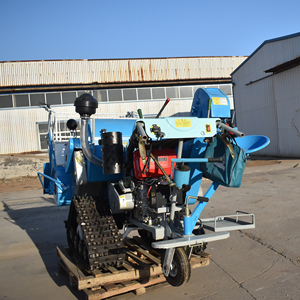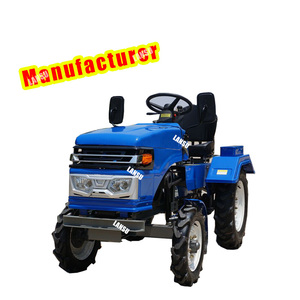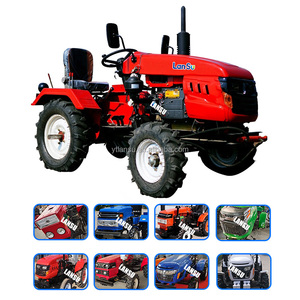
All categories
Featured selections
Trade Assurance
Buyer Central
Help Center
Get the app
Become a supplier

(1276 products available)



























The CLAAS combine harvester is a modern agricultural machine that harvests grain from all types of cereal crops. It can also be used to harvest cash crops such as soybean, pea, sunflower, and maize. The main steps CLAAS combines perform during harvesting include cutting down the crops, threshing the grains, winnowing to separate the grains from other debris, and finally, loading the grains onto a truck or container.
The CLAAS combine harvester can be divided into the following types based on functionality:
Classical Combine:
The classical CLAAS combine harvester features traditional three-step threshing. It consists of a cylinder and concave that separate the grains from the straw. The classical combines are suitable for various crops and field conditions but may be less efficient in straw processing than rotary models.
Rotary Combine:
Rotary combines are based on the principle of rotary threshers. They feature cylindrical rotors with threshing sections rotating inside a concave. The rotary combines provide substantial space for separating grains from straw by easily passing through the concave. This method enhances the extraction of grains from the straw while simultaneously improving straw decomposition in the field. Such CLAAS combine harvesters are particularly well-suited for handling crops with high straw content, like rice and wheat.
Hybrid Combine:
Hybrid combines incorporate features of classical and rotary threshing systems. They provide flexibility in harvesting various crops and optimizing straw management according to specific field requirements.
Mega Combine:
The mega combine harvester is a larger and more high-capacity model within the CLAAS combine range. It is suitable for large-scale farming operations and features high performance, advanced technologies, and efficient grain processing capabilities. The mega combines also include self-propelled models, which are large, autonomous machines that can harvest their own crops.
The CLAAS combine harvester features many essential specifications, including engine power, cutting width, tank size, overall dimensions, and harvesting technology.
Combine harvesters need regular maintenance to make sure they work well and keep them in good condition as best as they can for a long time. The following are some typical maintenance tips.
The utilization of agricultural machine harvesters like the Claas combine harvester can be divided into four main categories based on grain type, terrain, and harvest requirements.
Choosing the right combine harvester requires a detailed study and understanding of some aspects.
Farm requirement analysis
Assess the type of crops harvested, total farmland, and harvest volume on the farm. Determine the needed harvesting width, productivity, and configuration of the machine. Also, consider if there is a special requirement for harvesting quality, such as maturity, cleanliness, and grading. Finally, evaluate the existing infrastructure, such as access roads and storage facilities, to ensure the harvested crop can be handled immediately.
CLAAS combine harvesters series
A predominant model of the field is the focus. For instance, the *Evolution Combine CLAAS Ackord 470* is mainly suitable for small-sized towns and crops such as wheat, corn, rice, soybeans, and sunflowers. The DAWN 4500 CLAAS Combine Harvester parts model is particularly suitable for small towns with tram lines and works effectively in wheat and paddy crops. In contrast, the hybrid model, such as Revolution Combine CLAAS 15 HP, is suitable for large fruit cultivation areas and can harvest various types of crops.
Other crucial features
The harvester should have a powerful engine and efficient fuel system for high productivity. Advanced separation and threshing systems enhance crop recovery and reduce grain damage. Grain processing systems, such as cleaning, grading, and binning, directly impact the quality and storage of harvested crops. A well-designed and ergonomic operator's cabin can improve operator comfort and productivity.
Maintenance and support
Consider the machine's maintenance and spare parts accessibility. Choose machines with easily replaceable parts and established maintenance networks. Evaluate the resale value and potential depreciation of the harvesters.
Q: How does a combine harvester work?
A: A combine harvester performs three major tasks - cutting, threshing and winnowing. It cuts the crops from the field using a cutter bar. The reaper then moves the cut crops to the machine's drum for the next process. The drum threshed the crops to separate the grains from the straw. Finally, the fan of the combine machine blows the lighter straw back into the field while the heavier grains fall into the storage bin.
Q: What are the types of combine harvesters?
A: There are two main types of combine harvesters - the front-reaper type and the rear-reaper type combines. The front-reaper type is more suitable for harvesting wheat, rice, and soybeans, while the rear-reaper type is suitable for crops of significant height like corn and sorghum.
Q: What are some advantages of using a combine harvester?
A: Using a combine harvester increases the efficiency of crop harvesting by 10-20 times as it combines three processes into one. It also improves the quality of harvested crops by reducing manual handling and the risk of damage to the grains. Lastly, combine harvesters save labor costs and reduce the need for manual workforce during harvest seasons.